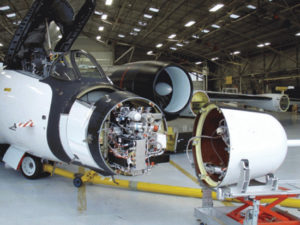Head in the clouds
Dan Cziczo models the cooling effect of airborne particles on Earth's climate

The team’s single particle mass spectrometer aboard NASA’s WB57.
Dan Cziczo, Victor P. Starr Career Development Associate Professor of Atmospheric Chemistry, can perform a magic trick—he can make a cloud appear in any room.
He begins with a glass jug with a little water in it, and runs a vacuum to lower the air pressure and encourage water vapor to condense. Although the conditions in the jug approximate the conditions in the sky, nothing happens. Water vapor alone isn’t enough to form a cloud.
But then Cziczo lights a match, blows it out, and tucks the smoking stub under the jug’s cap. Instantly, a thick cloud forms around the thin wisps of smoke.
Cziczo’s “magic trick,” which he performed at the Dean’s Breakfast on February 19, 2015, is a tabletop demonstration of an important principle that shapes the skies: Clouds require particulate aerosols—airborne dust, smoke, and other matter—to form.
At the breakfast, Cziczo shared his research on how the size, shape, and chemical properties of airborne particles (or “aerosols”) influence the formation of clouds. Aerosols and the clouds they form act as significant cooling forces in the global climate, but scientists can’t say with confidence exactly how big that cooling effect has been—or will be in the future. In order to build more reliable predictive models of climate change, we need a better understanding of aerosols.
In current models of the climate, the effect of greenhouse gases, carbon dioxide in particular, are very well understood. The role of carbon dioxide as a greenhouse gas has been established for nearly 120 years; Swedish scientist Svante Arrhenius first calculated in 1896 that doubling the concentration of carbon dioxide would result in a 3-5° increase in temperature. Since Arrhenius’ prediction, the concentration of carbon dioxide has, in fact, nearly doubled. The last decade was the hottest on record since the 1880s, when reliably accurate thermometers became available, and is likely the hottest decade in thousands of years. 2014 was the hottest year on record, with 2015 on pace to be even hotter. Globally averaged, the planet is 1.3° F warmer than it was in 1880.
However, Earth’s overall climate has not warmed as much as Arrhenius predicted in 1896, in part because he did not take into account the cooling effect of particulates. Aerosols scatter light from the sun back into space and are responsible for the formation of clouds, which also play a major role in the absorption and reflection of heat and light. Before industrial activity, most particulates came from sea salt, dust, and smoke from wildfires. Because there were few particles that could attract water vapor, the ice crystals and water droplets that formed around them tended to be bigger. The resulting clouds tended to be darker and thus were more likely to absorb light. After the advent of industrial activity, along with overgrazing, burning forests, and draining lakes, there have been more and more particles dispersed in the same amount of water vapor. Surprisingly, clouds tend to be whiter now and to reflect rather than absorb light.
In the laboratory, Cziczo uses cloud chambers—sophisticated versions of the glass jug—to study how different kinds of particles affect ice crystal and water droplet formation under controlled conditions. But, a significant portion of his research takes Cziczo out of the laboratory, on to mountaintops and into aircraft to observe cloud formation in situ and to collect samples.
Cziczo started his career, not as a climate scientist, but as an aerospace engineer at the NASA Jet Propulsion Laboratory (JPL), working on the orbital mechanics of the Galileo probe.
In working closely with scientists who used the probe to study the atmosphere of Jupiter, he was inspired to pursue a PhD in atmospheric science. He expected to go to CalTech and then return to JPL, but a meeting with John Abbatt on a visit to Chicago turned Cziczo’s attention Earth-wards. Abbatt’s talk about his new project on particles and cloud formation piqued Cziczo’s interest, and he joined Abbatt at the University of Chicago, working mostly in the laboratory. Since becoming a faculty member in 2011 in MIT’s Department of Earth, Atmospheric and Planetary Sciences, Cziczo has combined his interests in aerospace and atmospheric science by taking to the clouds in repurposed military aircraft to gather and analyze his samples.
Cziczo’s laboratory is developing new ways to study clouds in situ, including using drones and other unmanned aircraft. The airplane that Cziczo currently uses costs $12,000 per hour to operate, while a retasked drone takes just one person to run and can go for hours for a much lower cost. Because the payloads of drones and other unmanned aircraft are much smaller than the payload of an airplane, Cziczo and some of his graduate students are now working to miniaturize the necessary instrumentation.